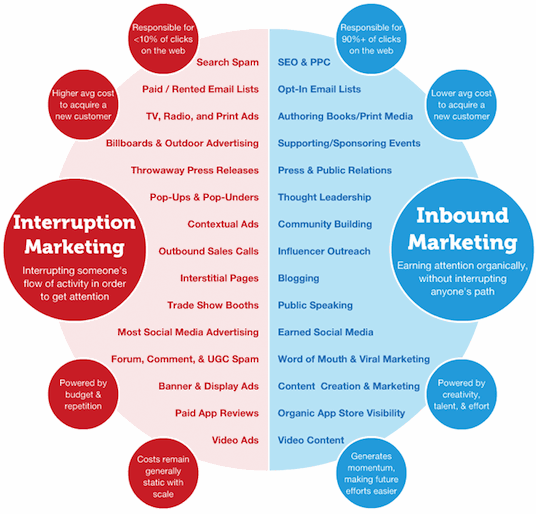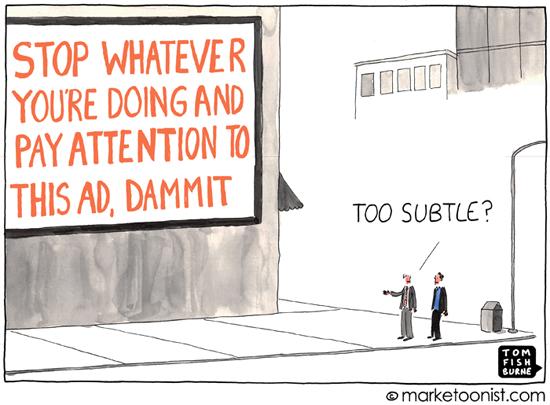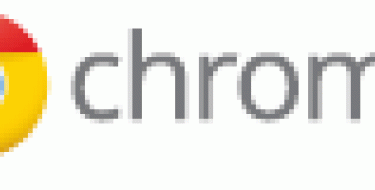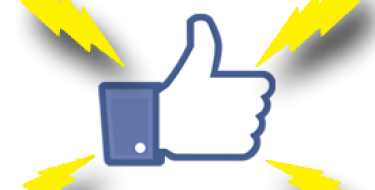Sorry to Interrupt, But Let's Talk Strategy
As the Internet and business worlds continue integrating, many businesses are switching from outbound (or “interruption”) marketing to inbound marketing, which provides businesses with an effective way to organically attract customers and build lasting relationships.
However, the use of interruption marketing is not necessarily obsolete. Let’s explore how to make the most of inbound marketing and which interruption marketing strategies are still beneficial to businesses.
Inbound vs. interruption marketing
Inbound marketing
Inbound marketing focuses on creating quality content that attracts people to a business organically. Rather than attempting to buy customers, inbound marketing specifically aligns a business’ content with the customers’ interests.
In layman’s terms, inbound marketing reaches the customer when they go looking for something to buy.
Interruption marketing
Interruption marketing refers to any form of advertising that interrupts someone’s flow of activity in order to get their attention.
This advertising strategy ranges from print and pop-up ads to paid app reviews. However, interruption marketing is becoming an outdated strategy due to inbound marketing. Although it attracts attention, it is rejected by users 90% of the time.
How to utilize inbound marketing
Creating and sharing content is key. In order for your marketing to be effective, your content must be designed to appeal to your target customer, thus attracting potential prospects to your business.
To fully optimize inbound marketing, you must integrate your content on multiple channels, like social media, your website, blogs, etc. This way you have a better chance of reaching your customer when they are searching for your product/service.
Once you develop a presence on multiple channels, you will be able to personalize your message throughout the channels, making it specific to your customers’ needs.
Four major steps to inbound marketing
There are four major steps to an inbound marketing strategy:
- Attract. Create content that aligns with your customer’s buyer persona, encompassing their personal and demographic information through blogging, social media, and SEO.
- Convert. Once you’ve attracted potential customers, convert them into leads by gathering their contact information. This can be done through calls-to-action buttons, landing pages, or asking them to subscribe to your newsletter.
- Close. Now that you’ve converted your visitors into leads, you need to turn them into customers. Some closing tools include emailing relevant content, marketing automation, and closed-loop reporting.
- Delight. Whether you’re dealing with leads or existing customers, you need to continue to produce attractive content. Continue to engage (and delight) your current customers through social media, email, and marketing automation.
By sticking to these steps, you connect with your target customers as they interact with your company through the buying cycle.
Instead of using interruptive methods, your marketing is relevant and helpful to your customers without having to shove advertisements in their face.
Now let me interrupt…
Despite the clear advantages of using inbound marketing, interruptive marketing still has a role in the consumer world. In fact, most social media advertising is considered to be on the interruption marketing side.
Personally, I think it will be a long time before traditional paid advertising disappears. The use of TV, radio, and print ads are still relevant in many markets.
Furthermore, interruptive marketing has benefits that inbound marketing cannot provide, like product sampling and reaching audiences that are not always online.
There are a few key strategies you should keep in mind when using an interruptive marketing strategy:
- Know your customers. No matter what strategy you implement, you will not be able to deliver your message effectively if you do not know who your customers are.
- Develop a persuasive USP and offer. A USP (unique selling proposition) describes what differentiates you from your competitors. The offer you deliver in your advertisement must stand out and show why you are unique. What can you offer that your competitors can’t?
So which one is for you?
In order to truly succeed with and optimize your marketing efforts, find a healthy balance of both marketing strategies. Inbound marketing is quickly becoming the leading marketing strategy — but some traditional marketing methods could still be a beneficial addition.

Strategy is key
Are you using an outdated or ineffective marketing strategy? Don’t fall short because of your strategy — download our free Marketing Plan for Growth to learn all you need to know about developing an inbound marketing plan.
[Image Credit: Tom Fishburne - license]
[Infographic Credit: Moz]
MONTHLY MARKETING INSIGHTS.
Get thought-provoking and actionable insights to improve how your firm makes a connection with your customers.





LEAVE A COMMENT